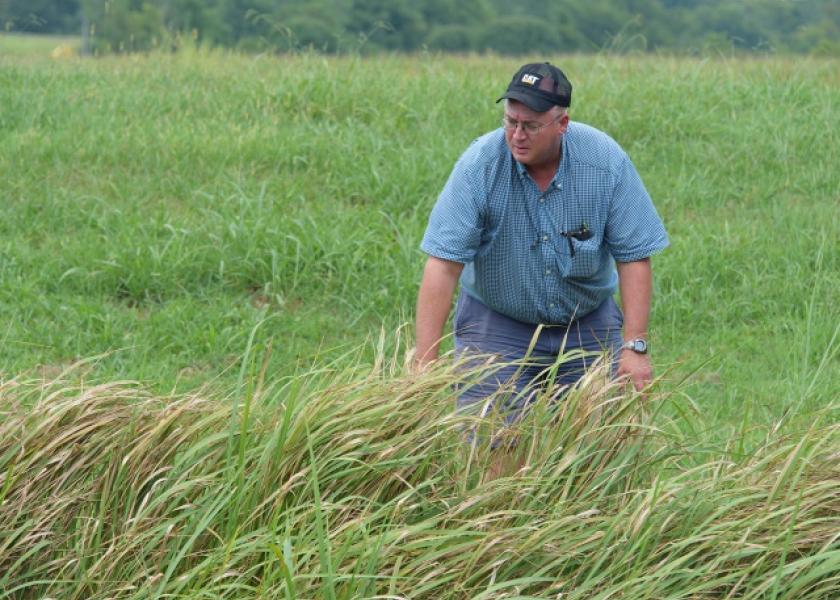Actively Battle Invasive Cogongrass in Mississippi

Cogongrass is a hardy, fast-growing invasive weed that is spreading across the Southeast.
By: Bonnie Coblentz, MSU Ag Communications
Cogongrass was introduced to Mississippi 100 years ago as a new forage crop, but it is now an invasive weed landowners and managers are trying to destroy.
John Byrd, weed scientist with the Mississippi State University Extension Service, said it was thought that this perennial grass had potential to benefit rural families.
“When cogongrass was introduced, families had to grow what they ate,” Byrd said. “Most rural families had a cow for milk and butter, and they needed to feed that cow during the winter. They also had hogs, which they raised in pastures where they would root up and eat rhizomes of grasses like cogongrass.”
With its vigorous growth and sturdy root system, cogongrass looked like a good forage and was even used in some places for soil stabilization.
“Although cogongrass looks like a superb forage, we learned animals that consume cogongrass as the sole forage lose weight rather than gain weight,” Byrd said.
Cogongrass is often seen along roadsides and in pastures. It looks like it has no stem, only leaves, and it grows in circular patches with little or no other vegetation interspersed. Its main identifying feature is the fluffy white seed heads it produces in spring.
“There are no other grasses that produce this type of seed head as early as cogongrass,” Byrd said.
After its introduction, cogongrass was identified as a weed, and efforts have been made to rid the state of this invasive species. Cogongrass spreads both by seed and roots, making it a tough plant to battle.
“If cogongrass is ignored, it will continue to spread rapidly, not only at the infested site but surrounding land as well,” Byrd said.
In addition to spreading through the roots, cogongrass seeds can be wind dispersed and travel for miles.
“We learned from research done along the Mississippi coast that the seed must fall on bare soil to germinate,” Byrd said. “Mulch, grass sod, leaf litter or other material that covers the soil surface will prevent seed germination. However, there are a lot of fire ant mounds with no soil covering that are prime potential invasion sites for cogongrass seed.”
Although it is hard to defeat, cogongrass can be battled with chemical control or with tillage and the reestablishment of a desirable cover crop. Mississippi State University Extension Service weed scientist John Byrd examines an area of dead cogongrass. (Photo by MSU Ag Communications/Kevin Hudson)
Cogongrass is most concentrated in south Mississippi, so landowners there are more likely to have the weed migrate onto their property. Preventive measures include making sure that exposed ground is covered and taking steps to ensure that contaminated soil is not transported to establish new populations. Farmers must clean tillage equipment that has been coated with soil containing cogongrass rhizomes before it can leave the site.
Landowners need to act when they find the spreading, invasive weed on their land.
“It’s a scenario of pay now or pay later,” Byrd said. “If a landowner chooses not to treat cogongrass, the patch will continue to expand so there is a larger area to treat a decade from now. Land is a limited resource, and as stewards of the land, we should make every attempt to leave it better than we found it.”
Byrd said repeated tillage with a rotary tiller will control this weed, but the ground must then be reseeded with some other plant.
“If a desirable cover is not established on the infested site, cogongrass will reinvade in a short time span,” he said.
Chemical options also are available. The most effective treatment is a two-step process using glyphosate and imazapyr. Correct timing and the proper chemical concentration and application method are key to successfully eliminating cogongrass from an area. Find recommendations in the “Cogongrass” fact sheet, which is free to download.
Michael Mathis, who works in invasive plant control with the Mississippi Forestry Commission, said cogongrass is a pest in 73 countries and considered to be one to the 10 worst weeds in the world.
“Cogongrass negatively affects pine productivity and survival, wildlife habitat, recreation, native plants, fire behavior and site management costs,” Mathis said. “Its ability to rapidly spread and displace desirable vegetation makes it particularly dangerous to native ecosystems.”
He said federal law prohibits the transport of this plant into and throughout the United States, but it continues to spread throughout the Gulf Coast states, threatening forests, rangelands, natural areas, roadsides and residential areas.
Cogongrass harms the land by invading a wide variety of habitats. It spreads rapidly, forming thick mats that exclude all other vegetation and reduce wildlife habitat. These infestations are extremely flammable and extremely difficult to control once established.
State regulations and recommendations for cogongrass control can be found at the Mississippi Bureau of Plant Industry website.







